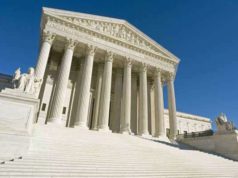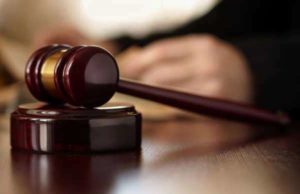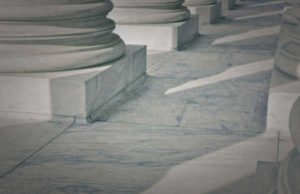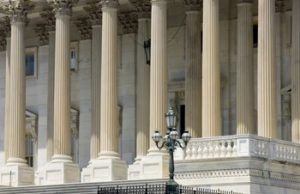
Supreme Court Justice: Clarence Thomas
Clarence Thomas is an Associate Justice of the United States Supreme Court and the second African American to serve. Succeeding Thurgood Marshall, Thomas is the second African American to serve as an Associate Justice on the Court. Clarence Thomas was born on June 23, 1948, and grew up in Georgia. He attended the College of the Holy Cross where he graduated cum laude with an A.B. in English literature. He went on to attend Yale Law School where he received his law degree in 1974.
As a Supreme Court Justice, Clarence Thomas has taken a very textualist approach to legislative interpretation, working to uphold the original meaning of the Constitution as well as the original meaning of statutes. Clarence Thomas is generally looked at as one of the most conservative members of the Supreme Court. He has very often approached issues of federalism in a way that limits the federal government’s power while expanding the power of local and state governments. Meanwhile, Clarence Thomas’s opinions have typically suggested a powerful role for the executive branch within the federal government.
Famous Cases
Adarand Constructors, Inc. v. Peña (1995): A Supreme Court case that stated that racial classifications that were imposed by the federal government needed to be analyzed under the standard of strict scrutiny. Strict scrutiny is the most critical level of review which states that racial classifications must be narrowly tailored in order to further compelling interests by the government. The majority opinion of the court, which included Justice Clarence Thomas, effectively overturned the precedent set by Metro Broadcasting, Inc. v. FCC (1990), where the Court had made a two-tiered system to analyze racial classifications. Adarand held the federal government to equal standards as both the local and state governments by using a process of “reverse incorporation,” where the Due Process Clause of the Fifth Amendment was used to bind the federal government to equal standards as the local and state governments are bound under the Constitution’s 14th Amendment.
Romer v. Evans (1996): A landmark Supreme Court decision regarding state laws and civil rights. The case was the first to deal with LGBT rights after Bowers v. Hardwick (1986), a case where the Supreme Court had ruled that a Georgia law that criminalized homosexual sex was constitutional. Romer v. Evans dealt with an amendment made to the Colorado state constitution which was passed by Colorado voters in a referendum that could have to prevent any town, county, or city in the state from taking any judicial, executive, or legislative action to recognize homosexual citizens as a protected class. A trial court issued an injunction against the amendment. Upon appeal, the Supreme Court of Colorado ruled that it was subject to “strict scrutiny” under the Fourteenth Amendment’s Equal Protection Clause. The state trial court concluded that it could not pass strict scrutiny, and the Colorado Supreme Court agreed with this upon review. The United States Supreme Court ruled that the amendment did not pass strict scrutiny or even the rational basis test in a 6-3 decision. The decision set a precedent that was used in Lawrence v. Texas (2003), where the Supreme Court overruled its previous court decision in Bowers. Justice Clarence Thomas joined Justice Scalia and Chief Justice Rehnquist in a dissent, which argued that the amendment did not deny access to the political process to homosexuals, but rather it simply made it more challenging to enact laws that were favorable to the minority. The dissent continued by saying that the majority decision completely contradicted the decision made in Bowers v. Hardwick.
United States v. Morrison (2000): is a decision made by the Supreme Court that stated that sections of the Violence Against Women Act (1994) were unconstitutional because the act passed by Congress exceeded congressional power under the Commerce Clause as well as under Section 5 of the Fourteenth Amendment to the Constitution. This act that was originally passed contained a provision regarding federal civil remedies for gender-based violence victims, even in cases where no charges were filed. The case revolved around an incident at Virginia Tech where a freshman student was allegedly assaulted and raped by members of the football team. One of the students admitted to having sexual contact with the student despite her protests. The college initially punished the student, but it was later struck down by the school administration. The Supreme Court affirmed the Fourth Circuit Court’s decision to support the U.S. District Court’s opinion that Congress had exceeded their power under the Constitution. While Justice Clarence Thomas was in the majority, he also had a concurring opinion which expressed concern about Congress appropriating state police powers under the name of commerce regulation.
Bush v. Gore (2000): A landmark Supreme Court decision on December 12, 2000, that resolved the controversy of the 2000 presidential election in favor of George W. Bush. Eight days before, the U.S> Supreme Court had decided unanimously the related case of Bush v. Palm Beach County Canvassing Board (2000) and three days before that, had preliminarily stopped the recount that was happening in Florida. The Court ruled in a per curiam decision that the Florida Supreme Court’s technique for the ballot recount violated the Fourteenth Amendment’s Equal Protection Clause. The Supreme Court also ruled that no other method could be made within the time limits that were created by Florida State. Justice Clarence Thomas joined Chief Justice Rehnquist’s concurring opinion, which emphasized that this specific case was unusual than others since the Constitution required the federal courts to decide if a state Supreme Court had correctly interpreted the state legislature’s will. After analyzing this aspect of the case, the concurring opinion then examined and supported the arguments which were made by the judges who dissented in the Florida Supreme Court.
Grutter v. Bollinger (2003): A Supreme Court case where the court upheld the affirmative action admissions policy set by the University of Michigan Law School in a 5-4 decision. The Supreme Court’s majority rule held that the U.S. Constitution did not specifically prohibit narrowly tailored use of race by the school in admissions to promote a compelling interest in obtaining educational benefits that result from a diverse student body. Justice Clarence Thomas’s opinion was partially concurring and dissenting and argued that if the school could not remain a prestigious institution while admitting students though a race-neutral system, the school should be forced to decide between a classroom aesthetic and exclusionary admissions. He also agreed with the dissent which felt a sense of disbelief in the validity of the claim made by the law school that the system used in admissions was needed to provide a diverse educational environment and create a critical mass of minority students.
Lawrence v. Texas (2003): A landmark Supreme Court case that struck down a sodomy law in Texas by a 6-3 ruling. In the previous case Bowers v. Hardwick (1986), the court had upheld a Georgia statute and claimed that there was no protection of sexual privacy in the constitution. The new ruling held that the previous case looked at liberty interest too narrowly. Justice Clarence Thomas joined Justice Scalia’s dissent, which objected to the decision to relook at the Bowers v. Hardwick case since there were many lower court decisions that could be affected. Justice Scalia also looked at the justification behind overturning the Bowers v. Hardwick and felt that these reasons could have also been used to overturn Roe v. Wade. Furthermore, the dissent suggested that other state laws against could become only sustainable with the validation of this previous case, such as same-sex marriage, bigamy, incest, masturbation, prostitution, bestiality, and obscenity. In a separate short dissent, Justice Clarence Thomas wrote that the law which was struck down by the court was silly, but because he could not find any relevant liberty or general right to privacy in the Constitution, he felt he had to uphold the law. Justice Thomas also mentioned that if he were a part of the Texas Legislature, he would have voted to repeal the sodomy law. However, he also did not feel that the plaintiffs had the standing to bring the case before the Court.
Georgia v. Randolph (2006): A Supreme Court case the Court held that the police did not have a constitutional right to search a house when one resident consented while the other resident objects to the search unless the police have a search warrant. The Supreme Court distinguished this particular case from the precedent established in United States v. Matlock (1974) regarding the “co-occupant consent rule”, which allowed one resident to consent in the absence of the other co-occupant. The case of Georgia v. Randolph was a good example of the continuing competition between proponents of the Living Constitution and Originalist philosophies that are applicable in United States jurisprudence and in the Supreme Court. The Court decided in a 5-3 majority opinion that a co-resident could refuse to give consent to a police search, even when another resident consented, specifically when such an evidentiary seizure is most likely lawful with one occupant’s permission when the other occupant, who seeks to suppress the evidence later, is currently present at the scene and explicitly refuses to consent. In these circumstances, a co-occupant who is physically present can refuse to allow entry, which makes the warrantless search invalid and unreasonable. Justice Clarence Thomas dissented and stated that would reverse the judgment of the Supreme Court of Georgia.
Gonzales v. Carhart (2007): A case in the Supreme Court that upheld the Partial-Birth Abortion Ban Act of 2003. The case reached the Supreme Court after Alberto Gonzales, the U.S. Attorney General appealed a ruling of in favor of LeRoy Carhart by the U.S. Court of Appeals for the Eighth Circuit that went against the Partial-Birth Abortion Ban Act. The majority decision by the Supreme Court, which included Justice Clarence Thomas, upheld Congress’s ban and stated that the act did not impose any sort of undue burden on a woman’s due process right to get an abortion. The opinion also stated that the respondents were unable to show that the U.S. Congress lacked the authority to ban the abortion procedure. This case was broadly interpreted as showing a shift in Supreme Court jurisprudence toward more restrictive abortion rights, partly due to Sandra Day O’Connor’s retirement and Samuel Alito acting as her replacement. Justice Clarence Thomas also filed a concurring opinion which briefly discussed whether Congress had the power to enact this ban under the Commerce Clause. The concurring opinion also stated that Justices Thomas joined the majority opinion because it correctly applied current jurisprudence, although the current abortion jurisprudence did not have a basis in the Constitution.
Citizens United v. Federal Election Commission (2010): A landmark 5–4 decision by the Supreme Court which held that the First Amendment of the Constitution prohibits the government from censoring any political broadcasts in candidate elections even if those broadcasts are funded entirely by corporations or unions. This Supreme court decision originated in an argument regarding whether Citizens United, a non-profit corporation, had the right to air a film which was critical of Hillary Clinton as well as whether the corporation could advertise the film as a broadcast ad which would feature Hillary Clinton’s image, which was an apparent violation of the Bipartisan Campaign Reform Act of 2002.
The case reached the Supreme Court from a 2008 case that was appealed from the District of Columbia District Court. The district court’s decision had allowed the provisions of the Bipartisan Campaign Reform act of 2002, which prevented the featuring Hillary Clinton from being televised within 30 days of Democratic primaries of 2008. The United States Supreme Court reversed the previous decision of the lower court, striking down the provisions of the 2008 act that barred all corporations, including not-for-profit and for-profit corporations as well as and unions from broadcasting any electioneering communications such as a cable, satellite, or broadcast communication which mentioned a candidate in a 60 day period before a general election or 30 days before a primary.
Justice Clarence Thomas joined the majority opinion, which stated that the prohibition of all independent expenditures made by both the unions and corporations was invalid and thus was not applicable to spending such as that in the movie. Furthermore, since there was no way to tell apart the media and other corporations, the restrictions could allow Congress to potentially suppress political speech found in books, television, blogs, or newspapers.
Justice Thomas also wrote a separate dissent where he stated that he would have struck down reporting requirements instead of challenging them on a case-by-case basis in order to protect anonymity for contributions that went to organizations that exercised free speech. The argument for this was that anonymous free speech would be protected, but contributor public lists could subject contributors to retaliation.






























